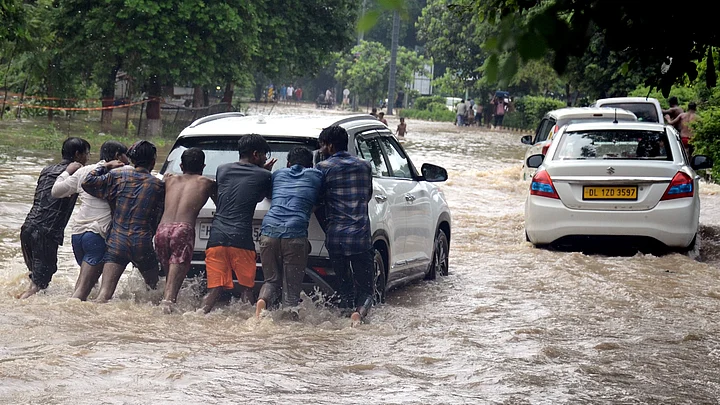(This article was originally published on 31 May 2017. It has been reposted from The Quint's archives in the context of heavy rainfall lashing parts of north India.)
The rains are here. With the rains come plenty of greenery and joy. But it also brings its own set of challenges. Be it driving in the rain or taking care of your car and bike or getting out of a sticky situation, we bring you some tips on how to prepare for the monsoon.
Preparing your Car or Bike for the Rains
The rains can cause plenty of water-logging on roads and if you aren’t careful, you could end up skidding badly on wet roads. There are a few things you need to take care of before venturing out in the rain on wet roads.
Tyres
Your tyres are your lifeline in the rain. Do not drive or ride on bald tyres as these can result in aquaplaning (a condition where water accumulates under the tyre and the car or bike floats on the water layer leading to a skid). You need to have at least 1 mm of tyre tread on your tyres.
A good way to check your tyre tread depth is to insert a Re 1 coin in the tread and see if the year printed at the bottom of the coin gets hidden in the tread. If it does, you have enough tread depth. If not, it would be a good idea to change your tyres before the monsoon.
Windshield Washer Fluid
Don’t forget to top up your windshield washer fluid. You can buy this from most auto accessories stores or a petrol pump. Or you can make your own by using a capful of mild shampoo with a litre of water. Don’t use dish-wash detergent as it is quite harsh and it can remove the wax polish layer from your car.
Wipers
The hot summer can take its toll on the rubber parts of the car, especially the windshield wipers. Exposure to hot sun makes the rubber brittle and it can tear. Since the rains usually follow a hot summer, most often motorists are caught out with poor performance from their wipers, leaving streaks and unwiped areas on the glass.
If the wipers are badly worn, they can cause expensive scratches on the windshield as well. As a rule, it’s best to change your wipers every year just before the monsoons.
Mud flaps
Ensure your car or bike has mud flaps behind the tyres. This will prevent road spray from getting thrown up from the road and splattering the car or bike behind you. In cases of bikes especially, road spray can get thrown up from the rear wheel and dirty the back of your clothing, if you don’t have a mud flap.
Lights
It becomes difficult to see in heavy rain. It becomes even more difficult for others to notice you in heavy rain. Hence it is wise to always use your headlamps or foglamps during a heavy downpour to warn other traffic. Ensure your lights are in working condition.
Driving in the Rain
Driving in the rain requires caution. The first thing you should do is to slow down to speeds where you can control your car or bike better. Remember, your brakes won’t function well when they are wet.
While blasting through a puddle may seem cool for photographs, it can be potentially dangerous. The sudden rush of water can destabilise your car or bike and lead to an accident. Or it can send water rushing into parts of the engine causing the car or bike to ingest water or short an electrical circuit.
If you must drive through a puddle of water, shift to a low gear drive through with high rpm but low speed to keep the water out of the exhaust. Unless you have a purpose-built SUV, don’t venture into water that is more than 500 mm or 1.5 feet deep.
To keep your windshield from misting up, use the AC with the airflow directed towards the windscreen. Keep the air circulation control in fresh air mode.
Equipping Yourself for the Rains
If you ride a bike, it’s a good time to invest in some good waterproof riding gear. For your boots, you could get rain covers to keep them dry. If you travel by car, get a couple of umbrellas and large plastic packets to keep the wet umbrellas in.
You can lay newspaper on your foot mats to absorb water from your shoes when you get into your car to prevent your carpets from getting wet.
Carry a tow rope just in case you get stranded and need to tow your car. Keep a battery pack handy to keep your phone charged to call in an emergency. Carry a water repellant spray like WD40, which can help dry electrical connections or spark plugs if you happen to go through a puddle, and find the car or bike stuttering or refusing to start.
Protecting your Car or Bike from Rain
Before the rains start, get your car or bike thoroughly serviced. Ensure that the brakes and tyres are in good condition. Give the paintwork a coat of wax polish that will prevent it from corrosion.
Spray all exposed joints, nuts and bolts with a rust-repellant spray. Don’t use waste oil like some service stations do, as that just attracts grime. If your car is going to be stationary for a long time, dust the seats and plastics with an anti-fungal powder to prevent mold from growing on it.
So go ahead, enjoy the rains, plug in your favourite music and head out on a long drive or ride!
(At The Quint, we question everything. Play an active role in shaping our journalism by becoming a member today.)
